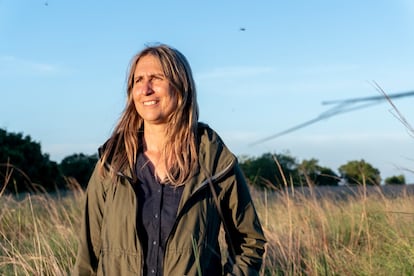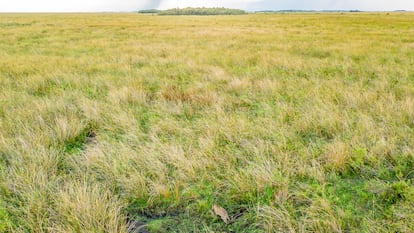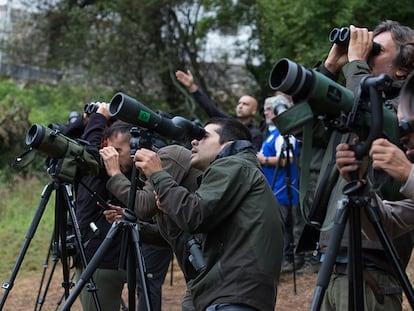Jaguars return to Argentina in ‘South America’s most complete species reintroduction project’
Sofía Heinonen, head of the Rewilding Argentina Foundation, says it took 15 years to get people to support the comeback of the largest land predator on the continent


The king of the jungle in the Americas is the jaguar, or yaguareté as it is mostly known in Argentina, a magnificent animal whose primary populations are found in the Amazon rainforest. Sometimes also called the American tiger, it is the largest land-based predator on the continent. Biologist Sofía Heinonen explains that the idea of returning these animals to their natural environment in a country with such as large cattle industry as Argentina’s was, at first, “seen as madness.” However, in 2021 the first eight specimens were released in the Esteros del Iberá wetlands in the province of Corrientes. It was one of the most eye-catching cases presented during the First Global Meeting of Conservation Translocation Practitioners, held a few days ago in Valencia, Spain. As Heinonen, director of the Rewilding Argentina Foundation, explains, in reality the jaguar is only one of several indigenous species her organization is attempting to help recover, part of a far more ambitious plan that includes the reintroduction of 14 different species, among them the giant otter, the pampas deer, the giant anteater, the collared peccary and the scarlet macaw.
Question. Why are you reintroducing 14 species at once?
Answer. The goal is to try and restore complete and functioning ecosystems, to prevent species from becoming extinct. We are not focused on threatened species that are on the red list, the idea is to recuperate an ecosystem is which the ecological roles continue to be resilient in the face of climate change so that there is no need to intervene afterward to ensure that nature can subsist. The more complex a system is, and the more relationships there are within it, the higher the possibility that it will continue to function. It’s like weaving: the more threads there are in a fabric, the more weight it can support.
Q. Why has a project like this come about in Argentina?
A. What we are doing in Argentina is the most complete reintroduction project in South America. On this continent, the priority for biodiversity was always protecting territory through the creation of national parks, but Argentina is among the first to turn to habitat restoration. This is because it has lost so many species. Argentina is a very flat country, it was very easy to colonize and it has a huge amount of livestock, unlike some other places that have mountain ranges.

Q. Where did the idea to reintroduce jaguars into Esteros del Iberá come from?
A. Esteros del Iberá is the biggest wetland in Argentina, at 1.5 million hectares. In 1998, [American philanthropist Douglas] Tompkins, who had been working to reintroduce wolves to Yellowstone, flew over it. While doing so, he realized there was an incredible opportunity to do something similar with the jaguar, because there were no major threats to the ecosystem and there was sufficient land extension for a population to live without conflicts. But he found that nobody in Argentina believed it was possible. In a conservative society like Argentina’s, where there are a lot of cattle ranches and private property holds a lot of sway, to think of introducing a top predator was crazy. I was at the time working for the national parks and to be honest it blew my mind, because I had never thought about it as something that was even possible.
Q. How did you achieve it?
A. Knowing how averse cattle ranchers can be toward these predators – they have persecuted them in the past because they see them as a threat – the first thing we saw we had to do was to change this perception. To turn fear into an opportunity. And this was done through a change in the economy; we had to make Esteros del Iberá be seen as an attractive destination for nature tourism, whose value would be increased by the return of the yaguareté. At the time there was nobody there but cattle ranchers, tourism didn’t exist, so we had to create a tourism industry from scratch.
Q. How long has that process taken?
A. Until the local communities asked for it, the politicians didn’t dare to authorize it. We had to create that moment at which society was ready to take it on board. It was a lengthy process; it took us 15 years to get people in Argentina to want to see the return of the yaguareté.
Q. So that means that the jaguar been reintroduced to Esteros del Iberá for the economy, for tourism?
A. Aside from economic motives, we found that the people of Corrientes, the province in which we work, felt very proud of their cultural ties with the yaguareté. They have a perception of themselves as being brave, just like the jaguar. Proposing bringing this big cat back gave them a sense of pride, because they couldn’t boast that they were brave if they didn’t have the jaguar. We found this out afterward and it came as a surprise. In this they can be compared to the Maasai, for whom living alongside lions is an act of courage.
Q. There are very few jaguars in the wild. How do you turn zoo animals into wild animals?
A. We had to fall back on something that everybody recommended against, which was having a nursery to release the second generation. The male adults came from zoos, but when they had cubs, we separated them from their mothers at the age of one and moved them to huge corrals, where they grew up in semi-captivity, with no human contact and hunting live prey. Some females from this group, who were already adults, were released with their young. The adults wear satellite collars so their movement can be monitored, but the cubs don’t have them. After a year and a half, these specimens are completely wild, they did not go through any process of confinement.

Q. How were the jaguars released in 2021?
A. They have been free for a year and a half now. First, we released three mothers with cubs, because that way they wouldn’t be able to go very far. When we ascertained that they were anchored, that is to say they had chosen their hunting territory, we released the male. Male jaguars generally roam much further than females and in covering more distance they can be exposed to more dangers. As such, we wanted to make sure that when we released the male there were already females in the territory who were in heat. This mechanism worked to a certain degree. The male never stops moving around but he is anchored by the females, he spends a week with each one.
Q. How many specimens are there in the wild now?
A. Of the eight specimens, we have three female adults with a male adult, who are constantly interacting, and four cubs without collars.
Q. During the year and a half they have been in the wild, has there been any conflict with livestock?
A. As they have 750,000 hectares of park, there have been no conflicts yet. When the population rises to 20 or 30 specimens, it is likely there will be some interaction with domestic livestock belonging to someone living on the boundaries of the park. But judging by what we know from the Pantanal, where there is a healthy jaguar population that co-exists with cattle ranching, it really isn’t a problem. And if society sees the yaguareté as a positive thing, I don’t think a rancher will change that.
Q. What is happening with the other reintroduced species?
A. To get to the yaguareté, we first had to educate society about the importance of bringing back other species that had become extinct in the area. We did this first with species where there is no possibility of conflict, like the giant anteater, the pampas deer, the collared peccary… these species have already been reintroduced and they are doing well. Now we are working with birds like the red-and-green macaw and the bare-faced curassow, which are important for forest restoration as they distribute seeds. And then we have a project with the giant otter, which is twice the size of the European otter. We are in the process of breeding them; we haven’t yet released any, there aren’t enough specimens yet.
Q. All of these species previously lived in the area?
A. Yes, all of these species were here originally, they were among the composition of the fauna in the same place around 100 years ago.
Q. How much has been invested in the restoration project?
A. The most expensive thing has been the purchase of land and setting up the infrastructure, which has taken around 15 years. The cost was about €28 million. After that, the actual management and reintroduction project rounds out at about €1million a year.
Q. Are we pushing nature to a point where it can only move ahead with human intervention?
A. If we create a park and remove livestock and stop cutting down trees, that will be sufficient for nature to return by itself. But there are times when such deterioration has been caused that this doesn’t work, because species have been extinguished altogether. If we have removed key pieces that evolved there and were necessary for seed distribution, reducing the size of pastures or other relationships, the system will continue to deteriorate because it does not have the capacity to replenish itself. We have to bring these pieces back.
Tu suscripción se está usando en otro dispositivo
¿Quieres añadir otro usuario a tu suscripción?
Si continúas leyendo en este dispositivo, no se podrá leer en el otro.
FlechaTu suscripción se está usando en otro dispositivo y solo puedes acceder a EL PAÍS desde un dispositivo a la vez.
Si quieres compartir tu cuenta, cambia tu suscripción a la modalidad Premium, así podrás añadir otro usuario. Cada uno accederá con su propia cuenta de email, lo que os permitirá personalizar vuestra experiencia en EL PAÍS.
¿Tienes una suscripción de empresa? Accede aquí para contratar más cuentas.
En el caso de no saber quién está usando tu cuenta, te recomendamos cambiar tu contraseña aquí.
Si decides continuar compartiendo tu cuenta, este mensaje se mostrará en tu dispositivo y en el de la otra persona que está usando tu cuenta de forma indefinida, afectando a tu experiencia de lectura. Puedes consultar aquí los términos y condiciones de la suscripción digital.
More information
Archived In
Últimas noticias
Daytime, headphones, no booze involved: How a generation is saying ‘no’ to club parties
Millennia-old Yuracaré language resists extinction through 900 speakers and a new dictionary
Susan Boyle prepares a comeback just as Timothée Chalamet sings her praises
Trump suspends green card visa lottery after shooting at Brown University
Most viewed
- Christian Louboutin: ‘Young people don’t want to be like their parents. And if their parents wear sneakers, they’re going to look for something else’
- Cartels in Mexico take a leap forward with narco-drones: ‘It is criminal groups that are leading the innovation race’
- Liset Menéndez de la Prida, neuroscientist: ‘It’s not normal to constantly seek pleasure; it’s important to be bored, to be calm’
- ‘El Limones’ and the growing union disguise of Mexican organized crime
- US sanctions against jailed cartel leader ‘El Marro’ highlight Mexico’s lack of control over its prisons









































